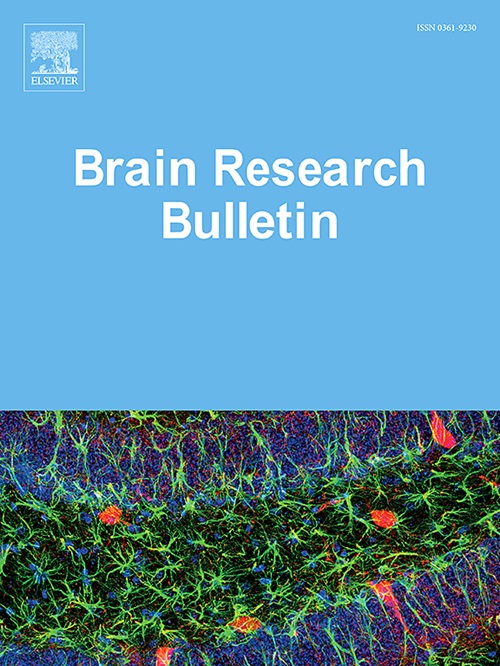Exploring neural changes associated with suicidal ideation and attempts in major depressive disorder: A multimodal study
IF 3.5
3区 医学
Q2 NEUROSCIENCES
引用次数: 0
Abstract
Suicidal ideation (SI) and suicide attempts (SA) are highly prevalent in individuals with major depressive disorder (MDD). To explore the structural and functional neural changes associated with SI and SA, we analyzed multimodal Magnetic Resonance Imaging (MRI) data from 159 participants, including those with MDD with suicide attempts (SA group, n = 34), those with MDD with suicidal ideation but not attempts (SI group, n = 53), those with MDD without suicidal ideation (NSI group, n = 14), and healthy controls (HC, n = 59). Voxel-based morphometry (VBM) analysis was performed to estimate and compare gray matter volume (GMV) across groups. Subsequently, a seed-based resting-state functional connectivity (rsFC) analysis was conducted to explore the functional networks associated with the structural brain changes related to suicidal ideation and suicide attempts. Compared with the HC and NSI groups, the SI group showed decreased GMV in the left dorsolateral prefrontal cortex (DLPFC), insula, fusiform gyrus, right posterior cerebellum, and right middle temporal gyrus. Additionally, when compared to the HC and SI groups, the SA group demonstrated smaller GMV in the right superior medial frontal gyrus (SFGmed), left superior and inferior occipital gyri, and superior temporal gyrus (STG), and right cuneus, but larger GMV in the right STG. Moreover, GMV in the insula, cerebellum posterior lobe, and SFGmed was negatively correlated with the scores of the Beck Scale for Suicide Ideation (BSSI). The rsFC analysis revealed weaker rsFC between the left insula and the left SFG as well as between the bilateral middle frontal orbital gyrus and the right SFGmed and the left middle occipital gyrus, but stronger rsFC of the right cerebellum posterior lobe with the left precentral gyrus and right parahippocampal gyrus among the SI group compared to the NSI group and HCs. Additionally, the SA group demonstrated weaker rsFC between the right cerebellum posterior lobe and the left cerebellum posterior lobe as well as the right lingual gyrus, but stronger rsFC between the right SFGmed and the left middle temporal gyrus and right inferior parietal lobule compared to the SI group. Our results indicate that structural and functional changes related to insula, DLPFC and cerebellum posterior lobe are associated with the generation and escalation of SI in MDD, while the structural and functional changes related to SFGmed and STG play a crucial role in the transformation from SI to SA in MDD.
在重度抑郁障碍中探索与自杀意念和企图相关的神经变化:一项多模式研究
自杀意念(SI)和自杀未遂(SA)在重度抑郁障碍(MDD)患者中非常普遍。为了探索与 SI 和 SA 相关的神经结构和功能变化,我们分析了 159 名参与者的多模态磁共振成像(MRI)数据,其中包括有自杀企图的 MDD 患者(SA 组,n = 34)、有自杀意念但无自杀企图的 MDD 患者(SI 组,n = 53)、无自杀意念的 MDD 患者(NSI 组,n = 14)和健康对照组(HC 组,n = 59)。通过体素形态计量(VBM)分析来估算和比较各组的灰质体积(GMV)。随后,进行了基于种子的静息态功能连接(rsFC)分析,以探索与自杀意念和自杀未遂相关的大脑结构变化有关的功能网络。与HC组和NSI组相比,SI组的左侧背外侧前额叶皮层(DLPFC)、脑岛、纺锤形回、右侧小脑后部和右侧颞中回的GMV有所下降。此外,与 HC 组和 SI 组相比,SA 组的右侧额叶内上回(SFGmed)、左侧枕上回和枕下回、颞上回(STG)以及右侧楔回的 GMV 较小,但右侧 STG 的 GMV 较大。此外,岛叶、小脑后叶和 SFGmed 的 GMV 与贝克自杀意念量表(BSSI)的评分呈负相关。rsFC分析显示,与NSI组和HCs相比,SI组的左侧脑岛与左侧SFG之间、双侧额叶中回与右侧SFGmed和左侧枕中回之间的rsFC较弱,但右侧小脑后叶与左侧中央前回和右侧海马旁回之间的rsFC较强。此外,与 SI 组相比,SA 组的右侧小脑后叶与左侧小脑后叶以及右侧舌回之间的 rsFC 较弱,但右侧 SFGmed 与左侧颞中回和右侧顶叶下叶之间的 rsFC 较强。我们的研究结果表明,与脑岛、DLPFC和小脑后叶相关的结构和功能变化与MDD中SI的产生和升级有关,而与SFGmed和STG相关的结构和功能变化在MDD中SI向SA的转变中起着至关重要的作用。
本文章由计算机程序翻译,如有差异,请以英文原文为准。
求助全文
约1分钟内获得全文
求助全文
来源期刊

Brain Research Bulletin
医学-神经科学
CiteScore
6.90
自引率
2.60%
发文量
253
审稿时长
67 days
期刊介绍:
The Brain Research Bulletin (BRB) aims to publish novel work that advances our knowledge of molecular and cellular mechanisms that underlie neural network properties associated with behavior, cognition and other brain functions during neurodevelopment and in the adult. Although clinical research is out of the Journal''s scope, the BRB also aims to publish translation research that provides insight into biological mechanisms and processes associated with neurodegeneration mechanisms, neurological diseases and neuropsychiatric disorders. The Journal is especially interested in research using novel methodologies, such as optogenetics, multielectrode array recordings and life imaging in wild-type and genetically-modified animal models, with the goal to advance our understanding of how neurons, glia and networks function in vivo.
 求助内容:
求助内容: 应助结果提醒方式:
应助结果提醒方式:


